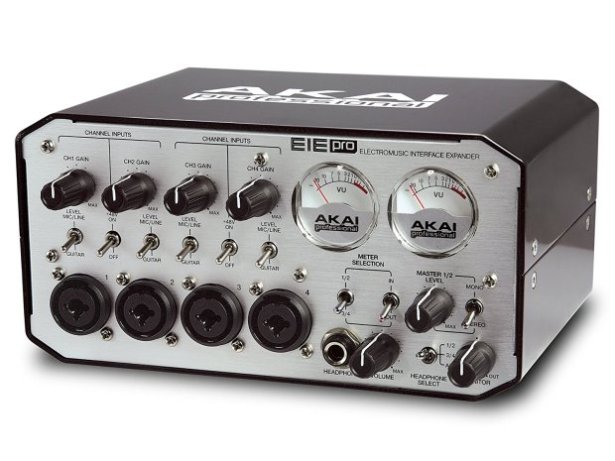Today I’ll be talking a bit about one of the backup interfaces that I use, the Akai EIE Pro. I picked this little box up about 5 years ago in Toronto, and it has served me fairly well for most of that time.

SPECIFICATIONS
Before we get too deep into personal opinions, we’ll take a look into the specs of this particular recording interface.
Within a solid metal chassis is 4 XLR-¼” inputs with corresponding preamps, Midi i/o, 4 ¼” audio inserts, 4 ¼” outputs, 3 USB ports, and some sassy looking VU meters. The +48v Phantom power is controlled by two switches corresponding to two channels each. The EIE pro handles every standard sample rate/bit depth leading up to 24-bit/96 kHz.
Running off USB2.0, this interface is one of the few middle children between the 2-channel starter interface, and the 8-channel standard interface.
DRIVER/SOFTWARE
Now, if my experience with the in-the-box CD driver on PC is to be trusted, it just didn’t do me justice. At least on my rig, the CD driver led to massive latency that the up-to-date version had no issue with.
Once all is set up, the driver is quite plug and play. A single option for buffer size makes things much easier than the more complex user interfaces have come out as of late. At a 256 block size, I get 12.5ms latency, which is perfectly reasonable for a device with a zero-latency output that can be mixed in when it really counts.

SOUND QUALITY
How does the beast sound? With these modern outboard soundcards, we’re mostly just looking at the preamp color and the A/D converters. On the preamp side, the goal and accomplishment has been clean and transparent, though nothing special to write home about. After a quick look around the internet, I had a hard time finding anyone saying anything negative/positive about the sound of the pre, nor a real adjective of its color.
The A/D converters fall into the same category, heavily functional, though nothing of note. Though it may be a product of two years of wear and tear, my potentiometers will occasionally give me a bit of crackle after not being used for a while, but a quick jiggle of the knob tends to warm it up pretty fast.
FEATURES
How are the features? As with a handful of interfaces coming out today, the EIE has an in/out knob to mix your monitor mix from a zero-latency interface input, against your computer’s output. The 3 USB ports on the back of the EIE are something I can’t remember the last time I have seen, but has been an ongoing treat for my mixing computer setup.
While a nice powered USB hub can serve the same purpose, having the extra location to have USB cables running towards can clean up a messy desk quickly. I was let down by how little I found myself using the VU meters on the box, due to my use of the device being entirely in the digital realm, but considering that it can continue to transmit audio without being plugged into the computer via USB, it could certainly be handy for approximately setting your pres while jamming, or using the box as a middleman between some other kind of audio setup than PC.
And it is to be noted that your metering can be adjusted from in-out, and 1/2-3/4, via the two switches below the VU meters.

COMPARISON
How does the EIE Pro hold up against similar units? At a quick look, the closest options to consider around the EIE Pro would be the Behringer UMC404, the Tascam US4X4, and the Presonus 44VSL 4X4. The only device of the three that can compete with the pricepoint is the Behringer.
While likely functional, and a touch cheaper, you would be giving up features, and be getting a brand many scoff at. The Tascam and Presonus would both be potentially solid options, but both cost more than the Akai, and drop the VU meters, and USB ports. Out of the four, I believe the Akai EIE Pro to be the clear winner in both pricepoint, and lasting appeal.
Though I like to think I was one of the less lucky ones, two of the preamps on the interface have degraded to useless over the last 5 years. Some serious points lost there for the Akai.
I will mention, I haven’t used these exact comparison products, but I have used the Behringer Ultragain Pro 8, Presonus Firestudio, and Tascam US-1800, and will be using the quality of those for scale.
WHO SHOULD BUY THIS
If you are still a ways away from mic’ing up a full kit, but are growing a little too big for your 2 channel Mbox/Scarlett/etc, check this one out. If you are looking for a starter interface, and haven’t already ended up with some 2-channel starter interface, putting the extra 50-100 dollars into this device will put you well above the curve that most start at, with some features you might miss moving along to larger recording interfaces. I know that I kept my Akai EIE Pro in use after purchasing my Focusrite Scarlett 18i20, even with two channels down.